publications
Publications from Fukushima lab. Authors who contributed as a Fukushima lab member are indicated in bold. Preview images are attached to papers in which members of our laboratory serve as either the lead or corresponding authors. †: co-first authors. *: (co-)corresponding authors.
2025
-
 Preprint Genome evolution and convergent innovation in the carnivorous plant Sarracenia purpureaVictor A. Albert*, Jonathan Kirshner, Christopher Page, Nicholas Pratt, Johanna Merkel, Michaela Richter, Matthias Freund, Kenji Fukushima, and Charlotte LindqvistbioRxiv : . Dec 2025
Preprint Genome evolution and convergent innovation in the carnivorous plant Sarracenia purpureaVictor A. Albert*, Jonathan Kirshner, Christopher Page, Nicholas Pratt, Johanna Merkel, Michaela Richter, Matthias Freund, Kenji Fukushima, and Charlotte LindqvistbioRxiv : . Dec 2025The repeated evolution of certain complex traits raises a fundamental question of how genomes generate ecological novelty while preserving developmental stability. Carnivorous pitcher plants, which modify a core organ of plant performance, the leaf, exemplify this challenge, yet the genomic basis of their convergent evolution has not been resolved. We present a chromosome-scale genome assembly for Sarracenia purpurea and analyze it alongside eight additional angiosperms spanning its parent clade Ericales and several other carnivorous lineages. The genome reveals extensive syntenic duplicate blocks arising from ancient polyploidy events, with diffuse, alternating dominant and recessive segments interleaved along chromosomes. Dominant regions are biased toward retained copies of dosage-sensitive regulatory genes, including AGO1, BRX, GATA11, ETC1 and RCD1. These genes highlight a conserved regulatory scaffold associated with leaf morphogenesis, including epidermal differentiation, auxin-mediated patterning, and redox-integrated coordination. By contrast, tandem gene duplications preferentially accumulate in structurally labile genomic regions and constitute a complementary, rapidly evolving component of the genome, enriched for ecological effector functions, including detoxification, glutathione-mediated redox buffering, antifungal pathways, and cuticle modification activities. Comparative union-based functional analyses across four carnivorous taxa reveal convergent recruitment of oxidative, transport, microbial-interaction, and cell-wall processes during independent trap evolution. Transcriptomic data confirm consistent activation of these pathways in pitchers. These findings demonstrate that complex traits arise through a genome-wide partitioning between polyploidy-derived, conserved developmental regulation and tandem-driven ecological specialization, here partitioning leaf architectural control from rapidly evolving functions associated with pitfall-based prey capture.
-
 Original Transcriptomic prey-capture responses in convergently evolved carnivorous pitcher plantsTakanori Wakatake*, and Kenji Fukushima*New Phytologist : . Dec 2025
Original Transcriptomic prey-capture responses in convergently evolved carnivorous pitcher plantsTakanori Wakatake*, and Kenji Fukushima*New Phytologist : . Dec 2025The Australian pitcher plant Cephalotus and the Asian pitcher plant Nepenthes exhibit striking morphological and functional similarities, serving as compelling examples of convergent evolution. Although trapping pitchers in both lineages represent some of the most elaborate leaf structures in angiosperms, it remains unknown whether their analogous phenotypes share common molecular foundations, especially at the level of gene expression. Here, we conducted tissue-specific RNA-seq experiments coupled with feeding treatments in C. follicularis, mirroring the available expression dataset of N. gracilis to analyze gene expression evolution underlying the phenotypic convergence. Functionally equivalent tissues in the two species tended to express similar gene sets, with common transcriptional responses that activate amino acid metabolism and protein synthesis upon the feeding treatment, yet with distinct transcriptional regulation of digestive enzyme genes. Additionally, we found multiple cases of combined convergence in expression and protein sequences in genes preferentially expressed in gland-containing tissues. Our study showcases how common and unique transcriptional components are integrated to shape the independent emergence of complex leaf structures in angiosperms.
-
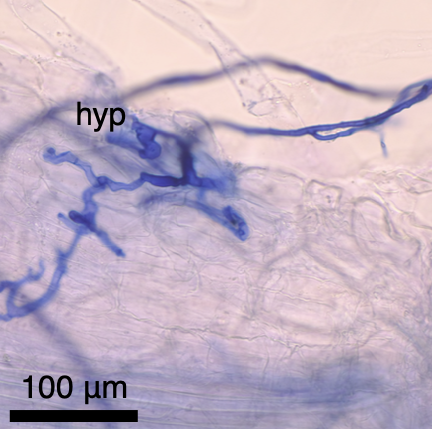 Original Convergent losses of arbuscular mycorrhizal symbiosis in carnivorous plantsHéctor Montero*, Matthias Freund, and Kenji Fukushima*New Phytologist 248: 2040-2051. Sep 2025
Original Convergent losses of arbuscular mycorrhizal symbiosis in carnivorous plantsHéctor Montero*, Matthias Freund, and Kenji Fukushima*New Phytologist 248: 2040-2051. Sep 2025Across evolutionary scales, lineages acquire and lose traits and associated genes. Most land plants form arbuscular mycorrhizal (AM) symbiosis, an ancient trait for enhanced nutrition that was convergently lost in some clades. Carnivory, another nutritional trait, is a more recent adaptation that has convergently arisen in several angiosperm orders. The two biotic interactions similarly help plants acquire mineral nutrients, raising the question of whether they can coexist. However, the mycorrhizal status of carnivorous plants has long remained speculative. Here, we surveyed the occurrence of AM-associated genes in five angiosperm orders harbouring carnivorous species, revealing convergent losses of the AM trait either coincident with or predating the emergence of carnivory. Exceptionally, the carnivorous plant species Roridula gorgonias retains symbiosis-related genes and forms arbuscules upon inoculation assays, demonstrating the two nutritional strategies, although rare, can coexist. The youngest carnivorous lineage, Brocchinia reducta, showed signatures of the early stages of AM trait loss, as reflected by its gene retention and AM colonization patterns. An AM-associated CHITINASE gene encodes a digestive enzyme in the Australian pitcher plant Cephalotus, suggesting gene co-option. These findings illuminate the largely unexplored processes by which plant nutritional strategies evolve and supplant one another over time.Competing Interest StatementThe authors have declared no competing interest.
-
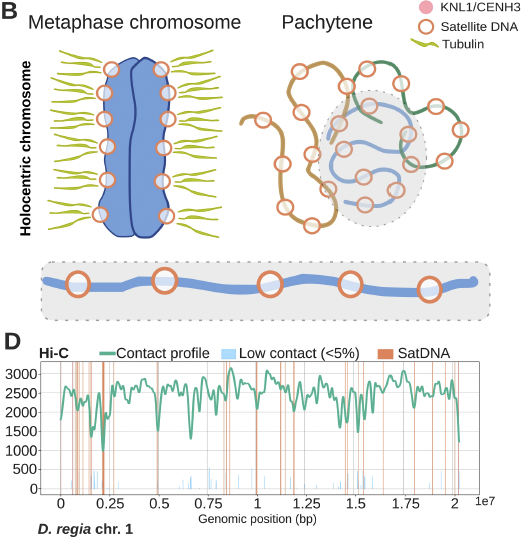 Preprint Complexity and innovation in carnivorous plant genomesVictor Albert*, Laura Ávila Robledillo, Steven J. Fleck, Yuhan Guo, Shunsuke Kanamori, Jonathan Kirshner, Andre Marques*, and Kenji Fukushima*Zenodo : . Aug 2025
Preprint Complexity and innovation in carnivorous plant genomesVictor Albert*, Laura Ávila Robledillo, Steven J. Fleck, Yuhan Guo, Shunsuke Kanamori, Jonathan Kirshner, Andre Marques*, and Kenji Fukushima*Zenodo : . Aug 2025Carnivorous plants are a paradigm of convergent evolution, but their genomes reveal even deeper layers of complexity. Recent work uncovers widespread polyploidy, including the decaploid East Asian pitcher plant (Nepenthes gracilis) genome and hybrid origins for the tetraploid Venus flytrap (Dionaea muscipula) and queen (hexaploid) and Cape (dodecaploid) sundews (Drosera regia and D. capensis, respectively). The bladderwort (Utricularia gibba) experienced extreme genome compaction while retaining otherwise typical gene number, challenging assumptions about genome size. Molecular convergence is conspicuous, from digestive enzyme recruitment to repeated amino acid substitutions under functional constraints. Drosera species further illustrate how centromere type (monocentric versus holocentric) shapes genome architecture. These discoveries position carnivorous plants as models for studying the plasticity and adaptive landscapes of plant genomes, including tradeoffs between local and global gene duplication and intergenic DNA deletion.
-
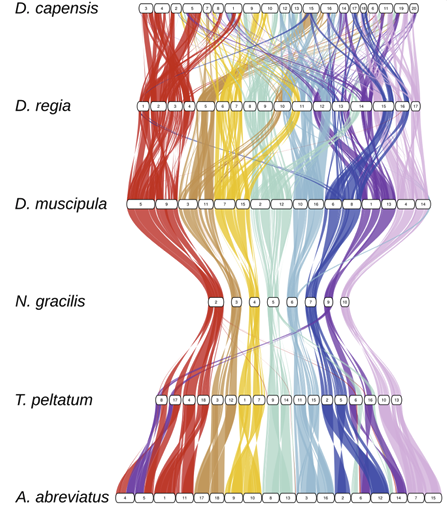 Preprint Contrasting centromere structures in carnivorous sundews uncover a dynamic evolutionary trajectory shaped by polyploidy and chromosomal remodelingLaura Ávila Robledillo, Steven J. Fleck, Jonathan Kirshner, Dirk Becker, Aaryan Bhatia, Gerhard Bringmann, Jordan R. Brock, Daniela Drautz-Moses, Matthias Freund, Rainer Hedrich, Luis Herrera-Estrella, Enrique Ibarra-Laclette, Ines Kreuzer, Tianying Lan, Sachiko Masuda, Martín Mata-Rosas, Todd P. Michael, Héctor Montero, Sitaram Rajaraman, Michaela Richter, David Sankoff, Stephan C. Schuster, Ken Shirasu, Sonja Trebing, Yves Van de Peer, Gerd Vogg, Tan Qiao Wen, Yue Zhang, Chunfang Zheng, Kenji Fukushima*, Jarkko Salojärvi*, André Marques*, and Victor A. Albert*bioRxiv : . Jul 2025
Preprint Contrasting centromere structures in carnivorous sundews uncover a dynamic evolutionary trajectory shaped by polyploidy and chromosomal remodelingLaura Ávila Robledillo, Steven J. Fleck, Jonathan Kirshner, Dirk Becker, Aaryan Bhatia, Gerhard Bringmann, Jordan R. Brock, Daniela Drautz-Moses, Matthias Freund, Rainer Hedrich, Luis Herrera-Estrella, Enrique Ibarra-Laclette, Ines Kreuzer, Tianying Lan, Sachiko Masuda, Martín Mata-Rosas, Todd P. Michael, Héctor Montero, Sitaram Rajaraman, Michaela Richter, David Sankoff, Stephan C. Schuster, Ken Shirasu, Sonja Trebing, Yves Van de Peer, Gerd Vogg, Tan Qiao Wen, Yue Zhang, Chunfang Zheng, Kenji Fukushima*, Jarkko Salojärvi*, André Marques*, and Victor A. Albert*bioRxiv : . Jul 2025Centromeres are essential for chromosome function, yet their role in shaping genome evolution in polyploid plants remains poorly understood. Allopolyploidy, where post-hybridization genome doubling merges parental genomes that may differ markedly in chromosomal architecture, has the potential to increase centromeric complexity and influence genomic plasticity. We explore this possibility in carnivorous Caryophyllales, a morphologically and chromosomally diverse plant lineage encompassing sundews, Venus flytraps, and Nepenthes pitcher plants. Focusing on sundews (Drosera), we generated chromosome-scale assemblies of holocentric D. regia and monocentric D. capensis, which share an allohexaploid origin but have diverged dramatically in genome structure. D. regia retains ancestral chromosomal fusions, dispersed centromeric repeats, and conserved synteny, whereas D. capensis exhibits extensive chromosomal reorganization and regionally localized centromeres after a lineage-specific genome duplication. Phylogenomic evidence traces D. regia to an ancient hybridization between sundew- and Venus flytrap-like ancestors, setting it apart within its infrageneric context. Genus-wide satellite DNA repeat profiling reveals rapid turnover and species-level variation in centromere organization. Together, these results establish sundews as a natural system for investigating how centromere dynamics interact with recurrent polyploidization and episodes of ecological innovation to shape genomic resilience.
-
 Original Emergence of isochorismate-based salicylic acid biosynthesis within BrassicalesKunqi Hong, Masahito Nakano, Ying Tang, Linda Jeanguenin, Wenshang Kang, Yongliang Wang, Lu Zuo, Pengyue Li, Jingjng He, Wanqing Jiang, Ruidong Huang, Hidenori Matsui, Yiming Wang, Hirofumi Nakagami, Bo Li, Xia Li, Kabin Xie, Kenji Fukushima, Liang Guo, Xiaowei Han, Fumiaki Katagiri, Motoyuki Hattori, and Kenichi Tsuda*Proceedings of the National Academy of Sciences of the United States of America 122: e2506170122. Jul 2025
Original Emergence of isochorismate-based salicylic acid biosynthesis within BrassicalesKunqi Hong, Masahito Nakano, Ying Tang, Linda Jeanguenin, Wenshang Kang, Yongliang Wang, Lu Zuo, Pengyue Li, Jingjng He, Wanqing Jiang, Ruidong Huang, Hidenori Matsui, Yiming Wang, Hirofumi Nakagami, Bo Li, Xia Li, Kabin Xie, Kenji Fukushima, Liang Guo, Xiaowei Han, Fumiaki Katagiri, Motoyuki Hattori, and Kenichi Tsuda*Proceedings of the National Academy of Sciences of the United States of America 122: e2506170122. Jul 2025Salicylic acid (SA) is a major defense phytohormone. In Arabidopsis thaliana, the isochorismate (IC) pathway is the primary route for pathogen-induced SA biosynthesis. First, the IC synthase (ICS) catalyzes the isomerization of chorismate to IC in chloroplasts. Second, the chloroplast-localized MATE transporter EDS5 appears to transport IC from chloroplasts to the cytosol. Cytosolic IC is then further converted to SA via the GH3 amino acid-conjugating enzyme PBS3. While this pathway is genetically well-characterized in A. thaliana, its evolutionary origin and conservation remain controversial. In this study, through comprehensive phylogenetic, structural, and functional analyses, we demonstrate that the IC pathway emerged within the Brassicales order in a time span between the divergence of Carica papaya and Capparis spinosa. The evolution of the IC pathway was driven by three key adaptations during the time span: 1) enhancement of ICS activity, 2) neofunctionalization of EDS5 after duplication of its ancestral gene, and 3) evolution of a PBS3, whose activity is specialized for glutamate-conjugation to IC. Structural modeling and functional assays reveal that an enhanced salt bridge network in ICS enhanced its activity. One of the duplicated genes, EDS5, acquired key amino acid substitutions in the C-lobe, which contributed to the EDS5 neofunctionalization. In addition, the functional PBS3 clade, including A. thaliana PBS3, is restricted to a Brassicales clade. Taken together, this study addresses the evolutionary trajectory of IC-based SA biosynthesis.
-
 Preprint Impaired trap closure in the counting-deficient Venus flytrap mutant DYSCALCULIA is caused by cell wall biomechanicsSonja Trebing, Matthias Freund, Anda Larisa Iosip, Celian Diblasi, Vincent Krennerich, Jonathan Kirshner, Mitsuhiko P Sato, Andre Marques, Marie Saitou, Dirk Becker, Victor A Albert, Ingrid Tessmer, Kenji Fukushima, Rainer Hedrich*, and Ines Kreuzer*bioRxiv : . Jun 2025
Preprint Impaired trap closure in the counting-deficient Venus flytrap mutant DYSCALCULIA is caused by cell wall biomechanicsSonja Trebing, Matthias Freund, Anda Larisa Iosip, Celian Diblasi, Vincent Krennerich, Jonathan Kirshner, Mitsuhiko P Sato, Andre Marques, Marie Saitou, Dirk Becker, Victor A Albert, Ingrid Tessmer, Kenji Fukushima, Rainer Hedrich*, and Ines Kreuzer*bioRxiv : . Jun 2025Living in nutrient-poor environments, the carnivorous Venus flytrap Dionaea muscipula captures animal prey to compensate for this deficiency. Stimulation of trigger hairs located on the inner trap surface elicits an action potential (AP). While two consecutive APs result in fast trap closure in wildtype (WT) plants, sustained AP generation by the insect struggling to escape the trap leads to jasmonic acid (JA) biosynthesis, formation of the digestive stomach, and release of enzymes needed to decompose the victim. The Dionaea muscipula DYSCALCULIA (DYSC) mutant is able to fire touch-induced APs, but unlike WT plants, it does not snap-close its traps after two consecutive APs. Moreover, DYSC plants fail to properly initiate the JA pathway in response to mechanostimulation and even wounding, a well-known JA-dependent process conserved among plants. As demonstrated in previous studies, this DYSC mutant defect is associated with impaired decoding of mechanostimulation (i.e. touch) -induced Ca2+ signals. External JA application to the trap, however, restores slow trap closure and digestive gland function in DYSC, while rapid trap closure is JA-independent and cannot be rescued by exogenous JA application. Higher frequency mechanostimulation and thus more APs, however, revealed that DYSC is still able to close its traps, albeit much slower than WT plants. To reveal the molecular underpinnings of DYSCs delayed trap movement, we generated a chromosome scale Dionaea genome assembly and profiled gene expression. The refined transcriptomic analysis uncovered widespread misregulation of cell wall related genes in DYSC, implicating altered cell wall plasticity in the sluggish mutant. Cell indentation studies by atomic force microscopy revealed a strictly localized and strikingly enhanced stiffening of the cell wall for DYSC that may hinder rapid trap closure and snap buckling. Together, these genomic, transcriptomic, and biophysical data identify cell wall elasticity as a key constraint on voltage and Ca2+ dependent trap kinetics. This finding documents the interrelationship between mechanosensing and Ca2+ signaling in the ultrafast capture organ of the Venus flytrap.
-
 Original Genomic signature and evolutionary history of completely cleistogamous lineages in the non-photosynthetic orchid GastrodiaKenji Suetsugu*, Shun K. Hirota, Takashi Makino, Yoshihisa Suyama, Shingo Kaneko, and Kenji Fukushima*Proceedings of the Royal Society B: Biological Sciences 292: 20250574. May 2025
Original Genomic signature and evolutionary history of completely cleistogamous lineages in the non-photosynthetic orchid GastrodiaKenji Suetsugu*, Shun K. Hirota, Takashi Makino, Yoshihisa Suyama, Shingo Kaneko, and Kenji Fukushima*Proceedings of the Royal Society B: Biological Sciences 292: 20250574. May 2025Despite a long-standing interest since Darwin’s time, the genomic implications of obligate self‐fertilization remain elusive. Complete cleistogamy—the obligate production of closed, self‐pollinating flowers—represents an extreme reproductive strategy. Here, we present the genomic profiles and evolutionary history of two lineages of the mycoheterotrophic orchid Gastrodia, both of which independently acquired complete cleistogamy, based on detailed sampling and a combination of simple sequence repeat (SSR), multiplexed ISSR genotyping by sequencing (MIG-seq) and RNA‐seq data. Our analysis reveals clear species delimitation, with no evidence of introgression between the completely cleistogamous species and their co‐occurring allogamous sisters. Intriguingly, all analyses indicate that both the completely cleistogamous Gastrodia species and their allogamous sisters exhibit genetic profiles typical of self‐pollinating plants. This pattern suggests that their ancestors, probably bearing allogamous flowers, had already evolved mechanisms to mitigate the deleterious effects of selfing, potentially facilitating the emergence of complete cleistogamy through benefits such as reproductive assurance, enhanced colonization ability and species reinforcement. Meanwhile, further analyses suggest that complete cleistogamy evolved very recently (possibly within the last 1000–2000 years) in these two Gastrodia lineages. Combined with the scant evidence of complete cleistogamy outside Gastrodia, our findings imply a limited and ephemeral role for complete cleistogamy in plant speciation.
-
 Preprint Molecular basis behind the isoprene emission diversity in FagaceaeSora Koita†, Ryosuke Munakata†, Kenji Fukushima, Atsushi J. Nagano, Yuka Ikezaki, Akiko Satake, Takuya Saito, Kenji Miura, Akifumi Sugiyama, and Kazufumi Yazaki*bioRxiv : . May 2025
Preprint Molecular basis behind the isoprene emission diversity in FagaceaeSora Koita†, Ryosuke Munakata†, Kenji Fukushima, Atsushi J. Nagano, Yuka Ikezaki, Akiko Satake, Takuya Saito, Kenji Miura, Akifumi Sugiyama, and Kazufumi Yazaki*bioRxiv : . May 2025Plants emit a large amount of volatile organic compounds (VOCs) into the atmosphere, reaching approximately 109 tons of carbon per year. These biogenic VOCs exhibit significant chemical diversity, with terpenoids being the dominant group, and isoprene accounting for nearly half of the total biogenic VOCs. Due to its high chemical reactivity, isoprene has a strong impact on atmospheric quality and climate. Quercus species (Fagaceae) are known to be the main isoprene emitters in the Northern Hemisphere. However, isoprene synthase is unknown in the entire Fagaceae family. Notably, even within a single genus such as Quercus, both isoprene-emitting and non-emitting species are present, yet the molecular basis of this dichotomy remains unclear. Here, we report the identification of the IspS gene from the isoprene-emitting species Quercus serrata (QsIspS1) through seasonal transcriptome analysis and its detailed biochemical characterization. We also identified two genes with high sequence similarity to QsIspS1 in the genomes of non-emitting species: Q. glauca (QgIspS1-like) and Lethocarpus edulis (LeIspS1-like). We discovered mutations in these sequences that likely impair their function. Biochemical analysis revealed that QgIspS1-like is a monoterpene synthase, whereas LeIspS1-like is a pseudogene incapable of isoprene synthesis, explaining these plants’ inability to emit isoprene. Furthermore, site-directed mutagenesis revealed an amino acid that plays a pivotal role in the substrate and product specificities of isoprene synthase. Our findings provide new insight into the molecular mechanisms of isoprene emission diversity in Fagaceae.
-
 Original Convergent acquisition of disulfide-forming enzymes in malodorous flowersYudai Okuyama*, Kenji Fukushima, Satoshi Kakishima, Anna K. Valchanova, Kohei Takenaka Takano, Yasuko Ito-Inaba, Takeru Nakazato, and Atsushi J. NaganoScience 388: 656-661. May 2025
Original Convergent acquisition of disulfide-forming enzymes in malodorous flowersYudai Okuyama*, Kenji Fukushima, Satoshi Kakishima, Anna K. Valchanova, Kohei Takenaka Takano, Yasuko Ito-Inaba, Takeru Nakazato, and Atsushi J. NaganoScience 388: 656-661. May 2025Identifying the metabolic and genetic changes that confer evolutionary novelty is essential for understanding the factors facilitating or constraining the occurrence of traits. We show that dimethyl disulfide (DMDS), a volatile compound that attracts saprophilous pollinators, is produced by a disulfide synthase (DSS) in the plant genus Asarum (Aristolochiaceae). DSS is derived from methanethiol oxidase (MTOX), an enzyme conserved among animals and plants, and similar DSS enzymes have independently evolved in two other plant genera. Three amino acid changes shared among the DSSs of independent origins were sufficient to cause a functional switch between MTOX and DSS. The small number of amino acid changes and the co-option of a highly conserved enzyme may explain why DMDS-emitting flowers are widespread among floral mimics.
-
 Review Construction costs and tradeoffs in carnivorous pitcher plant leaves: towards a pitcher leaf economic spectrumKadeem Jamal Gilbert*, David W. Armitage, Ulrike Bauer, Kenji Fukushima, Laurence Gaume, Rachel Love, Qianxi Lin, Sukuan Liu, Sylvie Martin-Eberhardt, Jonathan Millett, Tanya Renner, Mathias Scharmann, and Chris ThorogoodAnnals of Botany : mcaf024. Mar 2025
Review Construction costs and tradeoffs in carnivorous pitcher plant leaves: towards a pitcher leaf economic spectrumKadeem Jamal Gilbert*, David W. Armitage, Ulrike Bauer, Kenji Fukushima, Laurence Gaume, Rachel Love, Qianxi Lin, Sukuan Liu, Sylvie Martin-Eberhardt, Jonathan Millett, Tanya Renner, Mathias Scharmann, and Chris ThorogoodAnnals of Botany : mcaf024. Mar 2025Leaf economic theory holds that physiological constraints to photosynthesis have a role in the coordinated evolution of multiple leaf traits, an idea that can be extended to carnivorous plants occupying a particular trait space that is constrained by key costs and benefits. Pitcher traps are modified leaves that may face steep photosynthetic costs: a high-volume, three-dimensional tubular structure may be less efficient than a flat lamina. While past research has investigated the photosynthetic costs of pitchers, the exact suite of constraints shaping pitcher trait variation remain under-explored—including constraints to carnivorous function. In this review, we describe various constraints arising from the dual photosynthetic and carnivorous functions of pitchers arising from developmental, functional, budgetary, and environmental factors. In addition, we identify the data required to establish the leaf economic spectrum (LES) for carnivorous pitcher plants (CPPs), and — owing to the multifunctional roles of pitcher leaves — discuss difficulties in placing pitchers onto existing frameworks. Because pitcher traps serve multiple functions, both photosynthesis and nutrient acquisition (carnivory), they are difficult to place in the context of the LES, especially in light of a current lack of trait data. We describe a spectrum across the independent CPP lineages in approaches to balancing carnivory-photosynthesis tradeoffs. Future efforts to collect relevant data can clarify the forces that shape observed pitcher trait variation, and increase understanding of principles that may be ultimately generalized to other plants.
2024
-
 Original Convergent emergence of glucomannan β-galactosyltransferase activity in asterids and rosidsKonan Ishida, Matthew Penner, Kenji Fukushima, Yoshihisa Yoshimi, Louis F.L. Wilson, Alberto Echevarrı́a-Poza, Li Yu, and Paul Dupree*Plant & Cell Physiology 65: 2030–2039. Oct 2024
Original Convergent emergence of glucomannan β-galactosyltransferase activity in asterids and rosidsKonan Ishida, Matthew Penner, Kenji Fukushima, Yoshihisa Yoshimi, Louis F.L. Wilson, Alberto Echevarrı́a-Poza, Li Yu, and Paul Dupree*Plant & Cell Physiology 65: 2030–2039. Oct 2024β-Galactoglucomannan (β-GGM) is a primary cell wall polysaccharide in rosids and asterids. The β-GGM polymer has a backbone of repeating β-(1,4)-glucosyl and mannosyl residues, usually with mono-α-(1,6)-galactosyl substitution or β-(1,2)-galactosyl α-galactosyl disaccharide side chains on the mannosyl residues. Mannan β-galactosyltransferases (MBGTs) are therefore required for β-GGM synthesis. The single MBGT identified so far, AtMBGT1, lies in glycosyltransferase family 47A subclade VII and was identified in Arabidopsis. However, despite the presence of β-GGM, an orthologous gene is absent in tomato (Solanum lycopersicum), a model asterid. In this study, we screened candidate MBGT genes from the tomato genome, functionally tested the activities of encoded proteins and identified the tomato MBGT (SlMBGT1) in GT47A-III. Interestingly therefore, AtMBGT1 and SlMBGT1 are located in different GT47A subclades. Furthermore, phylogenetic and glucomannan structural analysis from different species raised the possibility that various asterids possess conserved MBGTs in an asterid-specific subclade of GT47A-III, indicating that MBGT activity has been acquired convergently among asterids and rosids. The present study highlights the promiscuous emergence of donor and acceptor preference in GT47A enzymes. The independent acquisition of the activity also suggests an adaptive advantage for eudicots to acquire β-GGM β-galactosylation and hence also suggests that the disaccharide side chains are important for β-GGM function.
2023
-
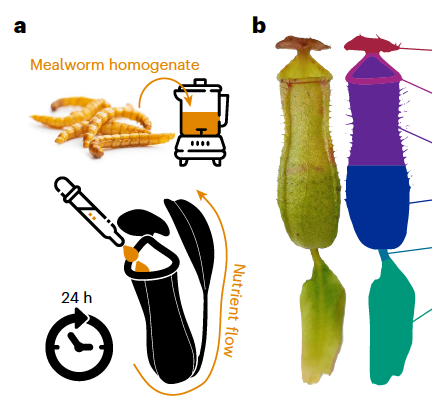 Original Subgenome dominance shapes novel gene evolution in the decaploid pitcher plant Nepenthes gracilisFranziska Saul†, Mathias Scharmann†, Takanori Wakatake, Sitaram Rajaraman, André Marques, Matthias Freund, Gerhard Bringmann, Louisa Channon, Dirk Becker, Emily Carroll, Yee Wen Low, Charlotte Lindqvist, Kadeem J. Gilbert, Tanya Renner, Sachiko Masuda, Michaela Richter, Gerd Vogg, Ken Shirasu, Todd P. Michael, Rainer Hedrich, Victor A. Albert*, and Kenji Fukushima*Nature Plants 9: 2000–2015. Dec 2023
Original Subgenome dominance shapes novel gene evolution in the decaploid pitcher plant Nepenthes gracilisFranziska Saul†, Mathias Scharmann†, Takanori Wakatake, Sitaram Rajaraman, André Marques, Matthias Freund, Gerhard Bringmann, Louisa Channon, Dirk Becker, Emily Carroll, Yee Wen Low, Charlotte Lindqvist, Kadeem J. Gilbert, Tanya Renner, Sachiko Masuda, Michaela Richter, Gerd Vogg, Ken Shirasu, Todd P. Michael, Rainer Hedrich, Victor A. Albert*, and Kenji Fukushima*Nature Plants 9: 2000–2015. Dec 2023Subgenome dominance after whole-genome duplication generates distinction in gene number and expression at the level of chromosome sets, but it remains unclear how this process may be involved in evolutionary novelty. Here we generated a chromosome-scale genome assembly of the Asian pitcher plant Nepenthes gracilis to analyse how its novel traits (dioecy and carnivorous pitcher leaves) are linked to genomic evolution. We found a decaploid karyotype and a clear indication of subgenome dominance. A male-linked and pericentromerically located region on the putative sex chromosome was identified in a recessive subgenome and was found to harbour three transcription factors involved in flower and pollen development, including a likely neofunctionalized LEAFY duplicate. Transcriptomic and syntenic analyses of carnivory-related genes suggested that the paleopolyploidization events seeded genes that subsequently formed tandem clusters in recessive subgenomes with specific expression in the digestive zone of the pitcher, where specialized cells digest prey and absorb derived nutrients. A genome-scale analysis suggested that subgenome dominance likely contributed to evolutionary innovation by permitting recessive subgenomes to diversify functions of novel tissue-specific duplicates. Our results provide insight into how polyploidy can give rise to novel traits in divergent and successful high-ploidy lineages.
-
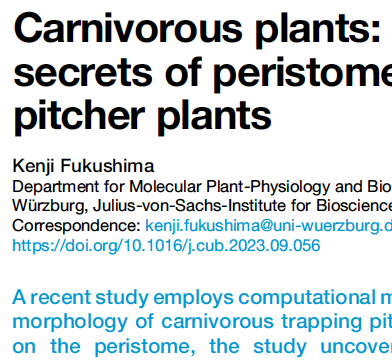 Dispatch Carnivorous plants: Unlocking the secrets of peristome geometry in pitcher plantsKenji Fukushima*Current Biology 33: R1155–R1157. Nov 2023
Dispatch Carnivorous plants: Unlocking the secrets of peristome geometry in pitcher plantsKenji Fukushima*Current Biology 33: R1155–R1157. Nov 2023A recent study employs computational models to explore the functional morphology of carnivorous trapping pitchers in Nepenthes. Focusing on the peristome, the study uncovers new dimensions in form–function relationships, offering theoretical insights into the role of complex trap morphology.
-
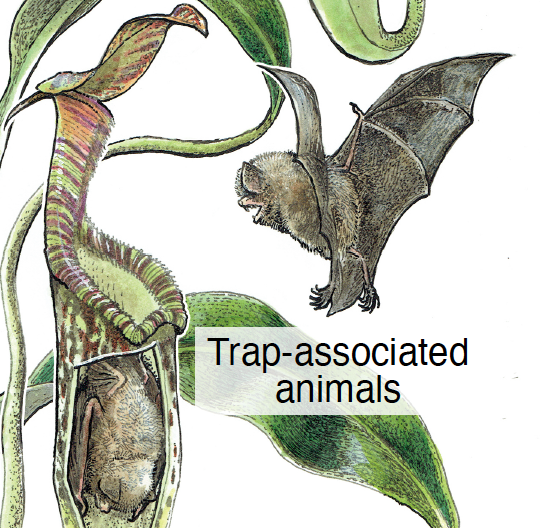 Primer Non-prey biotic interactions in carnivorous plantsHéctor Montero, and Kenji Fukushima*Current Biology 33: R497–R500. Jun 2023
Primer Non-prey biotic interactions in carnivorous plantsHéctor Montero, and Kenji Fukushima*Current Biology 33: R497–R500. Jun 2023Carnivorous plants often spark broad interest due to their specialized adaptations for trapping and consuming animals. These notable organisms not only fix carbon through photosynthesis, but they also obtain essential nutrients such as nitrogen and phosphate from their captured prey. In typical angiosperms, interactions with animals are usually confined to such processes as pollination and herbivory, but another layer of complexity in these interactions is added for carnivorous plants. Here, we introduce carnivorous plants and their associated organisms — ranging from their prey to their symbionts — and highlight biotic interactions beyond carnivory to discuss how the ‘default’ interactions typical for flowering plants have changed in the case of the carnivorous plants (Figure 1).
-
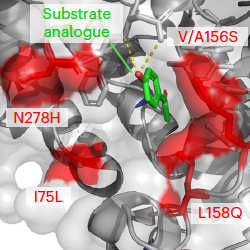 Original Detecting macroevolutionary genotype–phenotype associations using error-corrected rates of protein convergenceKenji Fukushima*, and David D. PollockNature Ecology & Evolution 7: 155–170. Jan 2023
Original Detecting macroevolutionary genotype–phenotype associations using error-corrected rates of protein convergenceKenji Fukushima*, and David D. PollockNature Ecology & Evolution 7: 155–170. Jan 2023On macroevolutionary timescales, extensive mutations and phylogenetic uncertainty mask the signals of genotype–phenotype associations underlying convergent evolution. To overcome this problem, we extended the widely used framework of non-synonymous to synonymous substitution rate ratios and developed the novel metric ωC, which measures the error-corrected convergence rate of protein evolution. While ωC distinguishes natural selection from genetic noise and phylogenetic errors in simulation and real examples, its accuracy allows an exploratory genome-wide search of adaptive molecular convergence without phenotypic hypothesis or candidate genes. Using gene expression data, we explored over 20 million branch combinations in vertebrate genes and identified the joint convergence of expression patterns and protein sequences with amino acid substitutions in functionally important sites, providing hypotheses on undiscovered phenotypes. We further extended our method with a heuristic algorithm to detect highly repetitive convergence among computationally non-trivial higher-order phylogenetic combinations. Our approach allows bidirectional searches for genotype–phenotype associations, even in lineages that diverged for hundreds of millions of years.
-
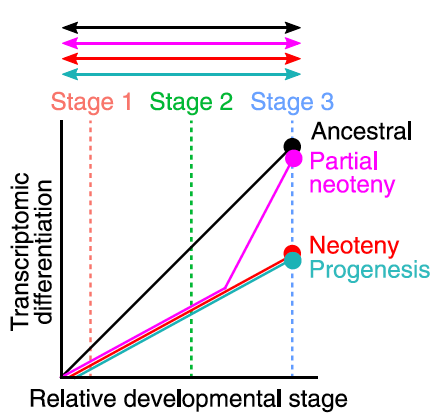 Original Transcriptomic heterochrony and completely cleistogamous flower development in the mycoheterotrophic orchid GastrodiaKenji Suetsugu†*, Kenji Fukushima†, Takashi Makino, Shuka Ikematsu, Tomoaki Sakamoto, and Seisuke Kimura*New Phytologist 237: 323–338. Jan 2023
Original Transcriptomic heterochrony and completely cleistogamous flower development in the mycoheterotrophic orchid GastrodiaKenji Suetsugu†*, Kenji Fukushima†, Takashi Makino, Shuka Ikematsu, Tomoaki Sakamoto, and Seisuke Kimura*New Phytologist 237: 323–338. Jan 2023Cleistogamy, in which plants can reproduce via self-fertilization within permanently closed flowers, has evolved in \textgreater 30 angiosperm lineages; however, consistent with Darwin’s doubts about its existence, complete cleistogamy – the production of only cleistogamous flowers – has rarely been recognized. Thus far, the achlorophyllous orchid genus, Gastrodia, is the only known genus with several plausible completely cleistogamous species. Here, we analyzed the floral developmental transcriptomes of two recently evolved, completely cleistogamous Gastrodia species and their chasmogamous sister species to elucidate the possible changes involved in producing common cleistogamous traits. The ABBA-BABA test did not support introgression and protein sequence convergence as evolutionary mechanisms leading to cleistogamy, leaving convergence in gene expression as a plausible mechanism. Regarding transcriptomic differentiation, the two cleistogamous species had common modifications in the expression of developmental regulators, exhibiting a gene family-wide signature of convergent expression changes in MADS-box genes. Our transcriptomic pseudotime analysis revealed a prolonged juvenile state and eventual maturation, a heterochronic pattern consistent with partial neoteny, in cleistogamous flower development. These findings indicate that transcriptomic partial neoteny, arising from changes in the expression of conserved developmental regulators, might have contributed to the rapid and repeated evolution of cleistogamous flowers in Gastrodia.
2022
-
 Update The digestive systems of carnivorous plantsMatthias Freund†, Dorothea Graus†, Andreas Fleischmann, Kadeem J. Gilbert, Qianshi Lin, Tanya Renner, Christian Stigloher, Victor A Albert, Rainer Hedrich, and Kenji Fukushima*Plant Physiology 190: 44–59. Sep 2022
Update The digestive systems of carnivorous plantsMatthias Freund†, Dorothea Graus†, Andreas Fleischmann, Kadeem J. Gilbert, Qianshi Lin, Tanya Renner, Christian Stigloher, Victor A Albert, Rainer Hedrich, and Kenji Fukushima*Plant Physiology 190: 44–59. Sep 2022To survive in the nutrient-poor habitats, carnivorous plants capture small organisms comprising complex substances not suitable for immediate reuse. The traps of carnivorous plants, which are analogous to the digestive systems of animals, are equipped with mechanisms for the breakdown and absorption of nutrients. Such capabilities have been acquired convergently over the past tens of millions of years in multiple angiosperm lineages by modifying plant-specific organs including leaves. The epidermis of carnivorous trap leaves bears groups of specialized cells called glands, which acquire substances from their prey via digestion and absorption. The digestive glands of carnivorous plants secrete mucilage, pitcher fluids, acids, and proteins, including digestive enzymes. The same (or morphologically distinct) glands then absorb the released compounds via various membrane transport proteins or endocytosis. Thus, these glands function in a manner similar to animal cells that are physiologically important in the digestive system, such as the parietal cells of the stomach and intestinal epithelial cells. Yet, carnivorous plants are equipped with strategies that deal with or incorporate plant-specific features, such as cell walls, epidermal cuticles, and phytohormones. In this review, we provide a systematic perspective on the digestive and absorptive capacity of convergently evolved carnivorous plants, with an emphasis on the forms and functions of glands.
-
 Preprint Genome sequence of 12 Vigna species as a knowledge base of stress tolerance and resistanceKen Naito*, Takanori Wakatake, Tomoko F. Shibata, Kohtaro Iseki, Shuji Shigenobu, Yu Takahashi, Eri Ogiso-Tanaka, Chiaki Muto, Kuniko Teruya, Akino Shiroma, Makiko Shimoji, Kazuhito Satou, Takashi Hirano, Atsushi J. Nagano, Norihiko Tomooka, Mitsuyasu Hasebe, Kenji Fukushima, and Hiroaki SakaibioRxiv : 2022.03.28.486085. Mar 2022
Preprint Genome sequence of 12 Vigna species as a knowledge base of stress tolerance and resistanceKen Naito*, Takanori Wakatake, Tomoko F. Shibata, Kohtaro Iseki, Shuji Shigenobu, Yu Takahashi, Eri Ogiso-Tanaka, Chiaki Muto, Kuniko Teruya, Akino Shiroma, Makiko Shimoji, Kazuhito Satou, Takashi Hirano, Atsushi J. Nagano, Norihiko Tomooka, Mitsuyasu Hasebe, Kenji Fukushima, and Hiroaki SakaibioRxiv : 2022.03.28.486085. Mar 2022Harnessing plant genetic resources including wild plants enables exploitation of agronomically unfavorable lands to secure food in the future. The genus Vigna, family Fabaceae, consists of many species of such kind, as they are often adapted to harsh environments including marine beach, arid sandy soil, acidic soil, limestone karst and marshes. Here we report long-read assemblies of 12 Vigna species, achieving 95% or higher BUSCO scores. The comparative analyses discovered a new class of WUSCHEL-related homeobox (WOX) transcription factor superfamily that are incorporated into LTR retrotransposons and have dramatically amplified in some species of the genus Vigna. Except WOX transcription factors, however, gene contents are highly conserved among Vigna species with few copy number variations. On the other hand, transcriptome data provided some insights that transcriptional alterations played more important roles in evolution of stress tolerance in the genus Vigna. The whole genome sequences presented in this study will facilitate understanding genetic mechanisms of stress tolerance and application for developing new crops that are adapted to unfavorable environments. Harnessing plant genetic resources including wild plants enables exploitation of agronomically unfavorable lands to secure food in the future. The genus Vigna, family Fabaceae, consists of many species of such kind, as they are often adapted to harsh environments including marine beach, arid sandy soil, acidic soil, limestone karst and marshes. Here we report long-read assemblies of 12 Vigna species, achieving 95% or higher BUSCO scores. The comparative analyses discovered a new class of WUSCHEL-related homeobox (WOX) transcription factor superfamily that are incorporated into LTR retrotransposons and have dramatically amplified in some species of the genus Vigna. Except WOX transcription factors, however, gene contents are highly conserved among Vigna species with few copy number variations. On the other hand, transcriptome data provided some insights that transcriptional alterations played more important roles in evolution of stress tolerance in the genus Vigna. The whole genome sequences presented in this study will facilitate understanding genetic mechanisms of stress tolerance and application for developing new crops that are adapted to unfavorable environments.
2021
-
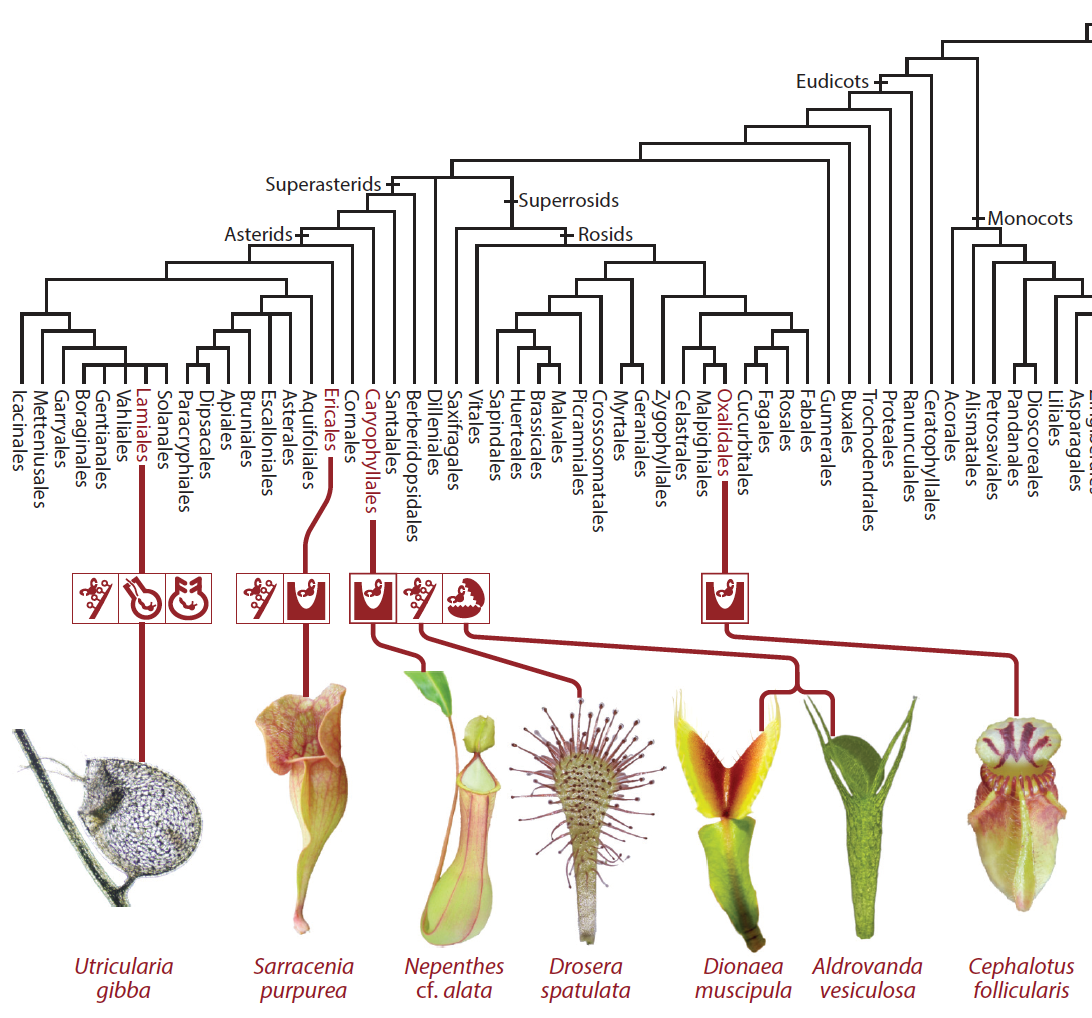 Review On the origin of carnivory: Molecular physiology and evolution of plants on an animal dietRainer Hedrich*, and Kenji Fukushima*Annual Review of Plant Biology 72: 133–153. Jun 2021
Review On the origin of carnivory: Molecular physiology and evolution of plants on an animal dietRainer Hedrich*, and Kenji Fukushima*Annual Review of Plant Biology 72: 133–153. Jun 2021Charles Darwin recognized that carnivorous plants thrive in nutrient-poor soil by capturing animals. Although the concept of botanical carnivory has been known for nearly 150 years, its molecular mechanisms and evolutionary origins have not been well understood until recently. In the last decade, technical advances have fueled the genome and transcriptome sequencings of active and passive hunters, leading to a better understanding of the traits associated with the carnivorous syndrome, from trap leaf development and prey digestion to nutrient absorption, exemplified, for example, by the Venus flytrap (Dionaea muscipula), pitcher plant (Cephalotus follicularis), and bladderwort (Utricularia gibba). The repurposing of defense-related genes is an important trend in the evolution of plant carnivory. In this review, using the Venus flytrap as a representative of the carnivorous plants, we summarize the molecular mechanisms underlying their ability to attract, trap, and digest prey and discuss the origins of plant carnivory in relation to their genomic evolution.
-
 Original Gene expression evolution in pattern-triggered immunity within Arabidopsis thaliana and across Brassicaceae speciesThomas M Winkelmüller, Frederickson Entila, Shajahan Anver, Anna Piasecka, Baoxing Song, Eik Dahms, Hitoshi Sakakibara, Xiangchao Gan, Karolina Kułak, Aneta Sawikowska, Paweł Krajewski, Miltos Tsiantis, Ruben Garrido-Oter, Kenji Fukushima, Paul Schulze-Lefert, Stefan Laurent, Paweł Bednarek, and Kenichi Tsuda*The Plant Cell 33: 1863–1887. Jun 2021
Original Gene expression evolution in pattern-triggered immunity within Arabidopsis thaliana and across Brassicaceae speciesThomas M Winkelmüller, Frederickson Entila, Shajahan Anver, Anna Piasecka, Baoxing Song, Eik Dahms, Hitoshi Sakakibara, Xiangchao Gan, Karolina Kułak, Aneta Sawikowska, Paweł Krajewski, Miltos Tsiantis, Ruben Garrido-Oter, Kenji Fukushima, Paul Schulze-Lefert, Stefan Laurent, Paweł Bednarek, and Kenichi Tsuda*The Plant Cell 33: 1863–1887. Jun 2021Plants recognize surrounding microbes by sensing microbe-associated molecular patterns (MAMPs) to activate pattern-triggered immunity (PTI). Despite their significance for microbial control, the evolution of PTI responses remains largely uncharacterized. Here, by employing comparative transcriptomics of six Arabidopsis thaliana accessions and three additional Brassicaceae species to investigate PTI responses, we identified a set of genes that commonly respond to the MAMP flg22 and genes that exhibit species-specific expression signatures. Variation in flg22-triggered transcriptome responses across Brassicaceae species was incongruent with their phylogeny, while expression changes were strongly conserved within A. thaliana. We found the enrichment of WRKY transcription factor binding sites in the 5′-regulatory regions of conserved and species-specific responsive genes, linking the emergence of WRKY-binding sites with the evolution of gene expression patterns during PTI. Our findings advance our understanding of the evolution of the transcriptome during biotic stress.
-
 Original A discordance of seasonally covarying cues uncovers misregulated phenotypes in the heterophyllous pitcher plant Cephalotus follicularisKenji Fukushima*, Hideki Narukawa, Gergo Palfalvi, and Mitsuyasu Hasebe*Proceedings of the Royal Society B: Biological Sciences 288: 20202568. Jan 2021
Original A discordance of seasonally covarying cues uncovers misregulated phenotypes in the heterophyllous pitcher plant Cephalotus follicularisKenji Fukushima*, Hideki Narukawa, Gergo Palfalvi, and Mitsuyasu Hasebe*Proceedings of the Royal Society B: Biological Sciences 288: 20202568. Jan 2021Organisms withstand normal ranges of environmental fluctuations by producing a set of phenotypes genetically programmed as a reaction norm; however, extreme conditions can expose a misregulation of phenotypes called a hidden reaction norm. Although an environment consists of multiple factors, how combinations of these factors influence a reaction norm is not well understood. To elucidate the combinatorial effects of environmental factors, we studied the leaf shape plasticity of the carnivorous pitcher plant Cephalotus follicularis. Clonally propagated plants were subjected to 12-week-long growth experiments in different conditions controlled by growth chambers. Here, we show that the dimorphic response of forming a photosynthetic flat leaf or an insect-trapping pitcher leaf is regulated by two covarying environmental cues: temperature and photoperiod. Even within the normal ranges of temperature and photoperiod, unusual combinations of the two induced the production of malformed leaves that were rarely observed under the environmentally typical combinations. We identified such cases in combinations of a summer temperature with a short-to-neutral day length, whose average frequency in the natural Cephalotus habitats corresponded to a once-in-a-lifetime event for this perennial species. Our results suggest that even if individual cues are within the range of natural fluctuations, a hidden reaction norm can be exposed under their discordant combinations. We anticipate that climate change may challenge organismal responses through not only extreme cues but also through uncommon combinations of benign cues.
-
 Opinion How to grow a tree: Plant voltage-dependent cation channels in the spotlight of evolutionIngo Dreyer*, Frances C. Sussmilch, Kenji Fukushima, Gonzalo Riadi, Dirk Becker, Jörg Schultz, and Rainer Hedrich*Trends in Plant Science 26: 41–52. Jan 2021
Opinion How to grow a tree: Plant voltage-dependent cation channels in the spotlight of evolutionIngo Dreyer*, Frances C. Sussmilch, Kenji Fukushima, Gonzalo Riadi, Dirk Becker, Jörg Schultz, and Rainer Hedrich*Trends in Plant Science 26: 41–52. Jan 2021Phylogenetic analysis can be a powerful tool for generating hypotheses regarding the evolution of physiological processes. Here, we provide an updated view of the evolution of the main cation channels in plant electrical signalling: the Shaker family of voltage-gated potassium channels and the two-pore cation (K+) channel (TPC1) family. Strikingly, the TPC1 family followed the same conservative evolutionary path as one particular subfamily of Shaker channels (Kout) and remained highly invariant after terrestrialisation, suggesting that electrical signalling was, and remains, key to survival on land. We note that phylogenetic analyses can have pitfalls, which may lead to erroneous conclusions. To avoid these in the future, we suggest guidelines for analyses of ion channel evolution in plants.
2020
-
 Original Calcium dynamics during trap closure visualized in transgenic Venus flytrapHiraku Suda, Hiroaki Mano, Masatsugu Toyota, Kenji Fukushima, Tetsuro Mimura, Izuo Tsutsui, Rainer Hedrich, Yosuke Tamada, and Mitsuyasu Hasebe*Nature Plants 6: 1219–1224. Oct 2020
Original Calcium dynamics during trap closure visualized in transgenic Venus flytrapHiraku Suda, Hiroaki Mano, Masatsugu Toyota, Kenji Fukushima, Tetsuro Mimura, Izuo Tsutsui, Rainer Hedrich, Yosuke Tamada, and Mitsuyasu Hasebe*Nature Plants 6: 1219–1224. Oct 2020The leaves of the carnivorous plant Venus flytrap, Dionaea muscipula (Dionaea) close rapidly to capture insect prey. The closure response usually requires two successive mechanical stimuli to sensory hairs on the leaf blade within approximately 30 s (refs. 1–4). An unknown biological system in Dionaea is thought to memorize the first stimulus and transduce the signal from the sensory hair to the leaf blade2. Here, we link signal memory to calcium dynamics using transgenic Dionaea expressing a Ca2+ sensor. Stimulation of a sensory hair caused an increase in cytosolic Ca2+ concentration ([Ca2+]cyt) starting in the sensory hair and spreading to the leaf blade. A second stimulus increased [Ca2+]cyt to an even higher level, meeting a threshold that is correlated to the leaf blade closure. Because [Ca2+]cyt gradually decreased after the first stimulus, the [Ca2+]cyt increase induced by the second stimulus was insufficient to meet the putative threshold for movement after about 30 s. The Ca2+ wave triggered by mechanical stimulation moved an order of magnitude faster than that induced by wounding in petioles of Arabidopsis thaliana5 and Dionaea. The capacity for rapid movement has evolved repeatedly in flowering plants. This study opens a path to investigate the role of Ca2+ in plant movement mechanisms and their evolution.
-
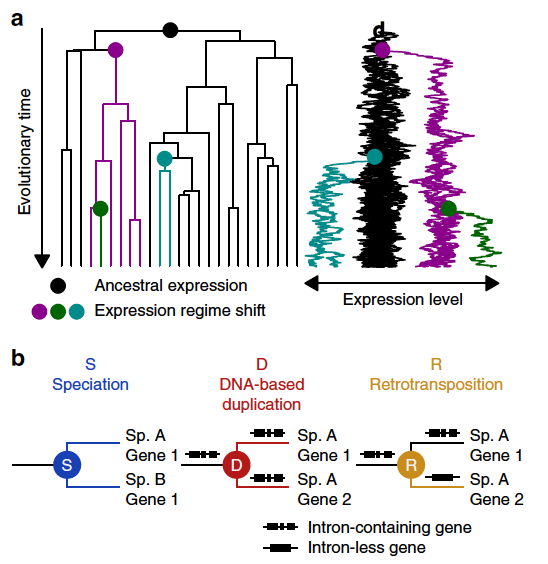 Original Amalgamated cross-species transcriptomes reveal organ-specific propensity in gene expression evolutionKenji Fukushima*, and David D. Pollock*Nature Communications 11: 4459. Sep 2020
Original Amalgamated cross-species transcriptomes reveal organ-specific propensity in gene expression evolutionKenji Fukushima*, and David D. Pollock*Nature Communications 11: 4459. Sep 2020The origins of multicellular physiology are tied to evolution of gene expression. Genes can shift expression as organisms evolve, but how ancestral expression influences altered descendant expression is not well understood. To examine this, we amalgamate 1,903 RNA-seq datasets from 182 research projects, including 6 organs in 21 vertebrate species. Quality control eliminates project-specific biases, and expression shifts are reconstructed using gene-family-wise phylogenetic Ornstein–Uhlenbeck models. Expression shifts following gene duplication result in more drastic changes in expression properties than shifts without gene duplication. The expression properties are tightly coupled with protein evolutionary rate, depending on whether and how gene duplication occurred. Fluxes in expression patterns among organs are nonrandom, forming modular connections that are reshaped by gene duplication. Thus, if expression shifts, ancestral expression in some organs induces a strong propensity for expression in particular organs in descendants. Regardless of whether the shifts are adaptive or not, this supports a major role for what might be termed preadaptive pathways of gene expression evolution.
-
 Original Genomes of the Venus flytrap and close relatives unveil the roots of plant carnivoryGergo Palfalvi†, Thomas Hackl†, Niklas Terhoeven†, Tomoko F. Shibata, Tomoaki Nishiyama, Markus Ankenbrand, Dirk Becker, Frank Förster, Matthias Freund, Anda Iosip, Ines Kreuzer, Franziska Saul, Chiharu Kamida, Kenji Fukushima, Shuji Shigenobu, Yosuke Tamada, Lubomir Adamec, Yoshikazu Hoshi, Kunihiko Ueda, Traud Winkelmann, Jörg Fuchs, Ingo Schubert, Rainer Schwacke, Khaled Al-Rasheid, Jörg Schultz*, Mitsuyasu Hasebe*, and Rainer Hedrich*Current Biology 30: 2312–2320.e5. May 2020
Original Genomes of the Venus flytrap and close relatives unveil the roots of plant carnivoryGergo Palfalvi†, Thomas Hackl†, Niklas Terhoeven†, Tomoko F. Shibata, Tomoaki Nishiyama, Markus Ankenbrand, Dirk Becker, Frank Förster, Matthias Freund, Anda Iosip, Ines Kreuzer, Franziska Saul, Chiharu Kamida, Kenji Fukushima, Shuji Shigenobu, Yosuke Tamada, Lubomir Adamec, Yoshikazu Hoshi, Kunihiko Ueda, Traud Winkelmann, Jörg Fuchs, Ingo Schubert, Rainer Schwacke, Khaled Al-Rasheid, Jörg Schultz*, Mitsuyasu Hasebe*, and Rainer Hedrich*Current Biology 30: 2312–2320.e5. May 2020Most plants grow and develop by taking up nutrients from the soil while continuously under threat from foraging animals. Carnivorous plants have turned the tables by capturing and consuming nutrient-rich animal prey, enabling them to thrive in nutrient-poor soil. To better understand the evolution of botanical carnivory, we compared the draft genome of the Venus flytrap (Dionaea muscipula) with that of its aquatic sister, the waterwheel plant Aldrovanda vesiculosa, and the sundew Drosera spatulata. We identified an early whole-genome duplication in the family as source for carnivory-associated genes. Recruitment of genes to the trap from the root especially was a major mechanism in the evolution of carnivory, supported by family-specific duplications. Still, these genomes belong to the gene poorest land plants sequenced thus far, suggesting reduction of selective pressure on different processes, including non-carnivorous nutrient acquisition. Our results show how non-carnivorous plants evolved into the most skillful green hunters on the planet.
2019
-
 Original Assembly and annotation of a draft genome of the medicinal plant Polygonum cuspidatumYonghong Zhang, Lanlan Zheng, Yan Zheng, Chao Zhou, Ping Huang, Xiao Xiao, Yongheng Zhao, Xincai Hao, Zhubing Hu, Qinhua Chen, Hongliang Li, Xuanbin Wang, Kenji Fukushima, Guodong Wang, and Chen Li*Frontiers in Plant Science 10: 1274. Oct 2019
Original Assembly and annotation of a draft genome of the medicinal plant Polygonum cuspidatumYonghong Zhang, Lanlan Zheng, Yan Zheng, Chao Zhou, Ping Huang, Xiao Xiao, Yongheng Zhao, Xincai Hao, Zhubing Hu, Qinhua Chen, Hongliang Li, Xuanbin Wang, Kenji Fukushima, Guodong Wang, and Chen Li*Frontiers in Plant Science 10: 1274. Oct 2019Polygonum cuspidatum (Japanese knotweed, also known as Huzhang in Chinese), a plant that produces bioactive components such as stilbenes and quinones, has long been recognized as important in traditional Chinese herbal medicine. To better understand the biological features of this plant and to gain genetic insight into the biosynthesis of its natural products, we assembled a draft genome of P. cuspidatum using Illumina sequencing technology. The draft genome is ca. 2.56 Gb long, with 71.54% of the genome annotated as transposable elements. Integrated gene prediction suggested that the P. cuspidatum genome encodes 55,075 functional genes, including 6,776 gene families that are conserved in the five eudicot species examined and 2,386 that are unique to P. cuspidatum. Among the functional genes identified, 4,753 are predicted to encode transcription factors. We traced the gene duplication history of P. cuspidatum and determined that it has undergone two whole-genome duplication events about 65 and 6.6 million years ago. Roots are considered the primary medicinal tissue and transcriptome analysis identified 2,173 genes that were expressed at higher levels in roots compared to aboveground tissues. Detailed phylogenetic analysis demonstrated expansion of the gene family encoding stilbene synthase and chalcone synthase enzymes in the phenylpropanoid metabolic pathway, which is associated with the biosynthesis of resveratrol, a pharmacologically important stilbene. Analysis of the draft genome identified 7 abscisic acid and water deficit stress-induced protein-coding genes and 14 cysteine-rich transmembrane module genes predicted to be involved in stress responses. The draft de novo genome assembly produced in this study represents a valuable resource for the molecular characterization of medicinal compounds in P. cuspidatum, the improvement of this important medicinal plant, and the exploration of its abiotic stress resistance.
2018
-
 Book chapter Carnivorous plant genomesTanya Renner, Tianying Lan, Kimberly M. Farr, Enrique Ibarra-Laclette, Luis Herrera-Esrella, Stephan C. Schuster, Mitsuyasu Hasebe, Kenji Fukushima, and Victor A. AlbertCarnivorous plants: Physiology, ecology, and evolution : 135–152. Dec 2018
Book chapter Carnivorous plant genomesTanya Renner, Tianying Lan, Kimberly M. Farr, Enrique Ibarra-Laclette, Luis Herrera-Esrella, Stephan C. Schuster, Mitsuyasu Hasebe, Kenji Fukushima, and Victor A. AlbertCarnivorous plants: Physiology, ecology, and evolution : 135–152. Dec 2018Carnivorous plant genome research has focused on members of the Lamiales and Oxalidales; the most complete sequences are for Utricularia gibba and Cephalotus follicularis. The size-limited U. gibba genome highlights the importance of small-scale tandem duplications, which likely play roles in this species’ carnivorous adaptation. Sequencing of the C. follicularis genome detected adaptive changes that may explain the evolution of traits associated with attraction, trapping, digestion, and absorption. Functional consequences of genes putatively missing in the U. gibba genome, yet present in other angiosperms, may have influenced the evolution of polyploidy, physiology, and a rootless Bauplan. Additional draft nuclear genomes and transcriptomes are available for carnivorous Caryophyllales, Ericales, Lamiales, and Poales, but are limited in quantity and quality. Chloroplast genomes of carnivorous Lentibulariaceae have revealed interesting patterns of gene loss, alterations in the proportion of repeat DNA, and plastome-wide increases in substitution rates.
-
 Preprint Markov katana: A novel method for Bayesian resampling of parameter space applied to phylogenetic treesStephen T. Pollard, Kenji Fukushima, Zhengyuan O. Wang, Todd A. Castoe, and David D. Pollock*bioRxiv : 250951. Jan 2018
Preprint Markov katana: A novel method for Bayesian resampling of parameter space applied to phylogenetic treesStephen T. Pollard, Kenji Fukushima, Zhengyuan O. Wang, Todd A. Castoe, and David D. Pollock*bioRxiv : 250951. Jan 2018Phylogenetic inference requires a means to search phylogenetic tree space. This is usually achieved using progressive algorithms that propose and test small alterations in the current tree topology and branch lengths. Current programs search tree topology space using branch-swapping algorithms, but proposals do not discriminate well between swaps likely to succeed or fail. When applied to datasets with many taxa, the huge number of possible topologies slows these programs dramatically. To overcome this, we developed a novel statistical approach for proposal generation in Bayesian analysis, and evaluated its applicability for the problem of searching phylogenetic tree space. The general idea of the approach, which we call ’Markov katana’, is to make proposals based on a heuristic algorithm using bootstrapped subsets of the data. Such proposals induce an unintended sampling distribution that must be determined and removed to generate posterior estimates, but the cost of this extra step can in principle be small compared to the added value of more efficient parameter exploration in Markov chain Monte Carlo analyses. Our prototype application uses the simple neighbor joining distance heuristic on data subsets to propose new reasonably likely phylogenetic trees (including topologies and branch lengths). The evolutionary model used to generate distances in our prototype was far simpler than the more complex model used to evaluate the likelihood of phylogenies based on the full dataset. This prototype implementation indicates that the Markov katana approach could be easily incorporated into existing phylogenetic search programs and may prove a useful alternative in conjunction with existing methods. The general features of this statistical approach may also prove useful in disciplines other than phylogenetics. We demonstrate that this method can be used to efficiently estimate a Bayesian posterior.
2017
-
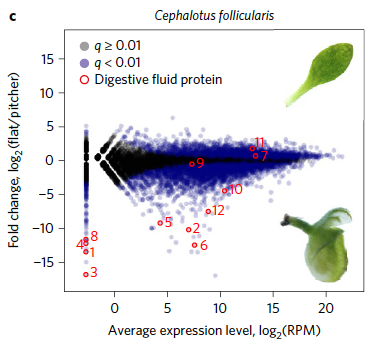 Original Genome of the pitcher plant Cephalotus reveals genetic changes associated with carnivoryKenji Fukushima†*, Xiaodong Fang†, David Alvarez-Ponce, Huimin Cai, Lorenzo Carretero-Paulet, Cui Chen, Tien-Hao Chang, Kimberly M. Farr, Tomomichi Fujita, Yuji Hiwatashi, Yoshikazu Hoshi, Takamasa Imai, Masahiro Kasahara, Pablo Librado, Likai Mao, Hitoshi Mori, Tomoaki Nishiyama, Masafumi Nozawa, Gergő Pálfalvi, Stephen T. Pollard, Julio Rozas, Alejandro Sánchez-Gracia, David Sankoff, Tomoko F. Shibata, Shuji Shigenobu, Naomi Sumikawa, Taketoshi Uzawa, Meiying Xie, Chunfang Zheng, David D. Pollock, Victor A. Albert*, Shuaicheng Li*, and Mitsuyasu Hasebe*Nature Ecology & Evolution 1: 0059. Feb 2017
Original Genome of the pitcher plant Cephalotus reveals genetic changes associated with carnivoryKenji Fukushima†*, Xiaodong Fang†, David Alvarez-Ponce, Huimin Cai, Lorenzo Carretero-Paulet, Cui Chen, Tien-Hao Chang, Kimberly M. Farr, Tomomichi Fujita, Yuji Hiwatashi, Yoshikazu Hoshi, Takamasa Imai, Masahiro Kasahara, Pablo Librado, Likai Mao, Hitoshi Mori, Tomoaki Nishiyama, Masafumi Nozawa, Gergő Pálfalvi, Stephen T. Pollard, Julio Rozas, Alejandro Sánchez-Gracia, David Sankoff, Tomoko F. Shibata, Shuji Shigenobu, Naomi Sumikawa, Taketoshi Uzawa, Meiying Xie, Chunfang Zheng, David D. Pollock, Victor A. Albert*, Shuaicheng Li*, and Mitsuyasu Hasebe*Nature Ecology & Evolution 1: 0059. Feb 2017Carnivorous plants exploit animals as a nutritional source and have inspired long-standing questions about the origin and evolution of carnivory-related traits. To investigate the molecular bases of carnivory, we sequenced the genome of the heterophyllous pitcher plant Cephalotus follicularis, in which we succeeded in regulating the developmental switch between carnivorous and non-carnivorous leaves. Transcriptome comparison of the two leaf types and gene repertoire analysis identified genetic changes associated with prey attraction, capture, digestion and nutrient absorption. Analysis of digestive fluid proteins from C. follicularis and three other carnivorous plants with independent carnivorous origins revealed repeated co-options of stress-responsive protein lineages coupled with convergent amino acid substitutions to acquire digestive physiology. These results imply constraints on the available routes to evolve plant carnivory.
2015
-
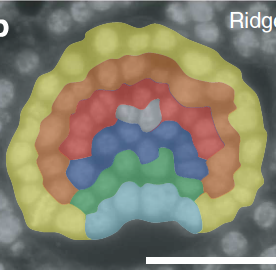 Original Oriented cell division shapes carnivorous pitcher leaves of Sarracenia purpureaKenji Fukushima, Hironori Fujita, Takahiro Yamaguchi, Masayoshi Kawaguchi, Hirokazu Tsukaya, and Mitsuyasu Hasebe*Nature Communications 6: 6450. Dec 2015
Original Oriented cell division shapes carnivorous pitcher leaves of Sarracenia purpureaKenji Fukushima, Hironori Fujita, Takahiro Yamaguchi, Masayoshi Kawaguchi, Hirokazu Tsukaya, and Mitsuyasu Hasebe*Nature Communications 6: 6450. Dec 2015The pitcher-shaped leaf of the carnivorous plant Sarracenia purpurea acts as a pitfall trap to capture small animals. Here, Fukushima et al. analyse pitcher leaf development and propose that this unusual shape evolved from ancestral planar leaves through changes in the orientation of cell division.
2014
-
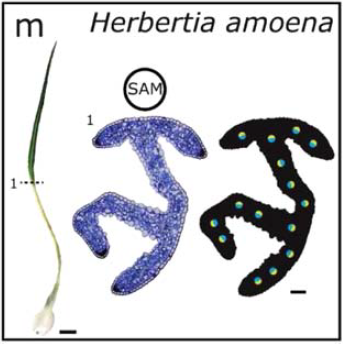 Review Adaxial–abaxial polarity: The developmental basis of leaf shape diversityKenji Fukushima*, and Mitsuyasu Hasebe*Genesis 52: 1–18. Jan 2014
Review Adaxial–abaxial polarity: The developmental basis of leaf shape diversityKenji Fukushima*, and Mitsuyasu Hasebe*Genesis 52: 1–18. Jan 2014Leaves of flowering plants are diverse in shape. Part of this morphological diversity can be attributed to differences in spatiotemporal regulation of polarity in the upper (adaxial) and lower (abaxial) sides of developing leaves. In a leaf primordium, antagonistic interactions between polarity determinants specify the adaxial and abaxial domains in a mutually exclusive manner. The patterning of those domains is critical for leaf morphogenesis. In this review, we first summarize the gene networks regulating adaxial–abaxial polarity in conventional bifacial leaves and then discuss how patterning is modified in different leaf type categories. genesis 1–18. © 2013 Wiley Periodicals, Inc.
-
 Original Molecular phylogeny determined using chloroplast DNA inferred a new phylogenetic relationship of Rorippa aquatica (Eaton) EJ Palmer & Steyermark (Brassicaceae)—lake cressHokuto Nakayama, Kenji Fukushima, Tatsuya Fukuda, Jun Yokoyama, and Seisuke Kimura*American Journal of Plant Sciences 5: 48–54. Jan 2014
Original Molecular phylogeny determined using chloroplast DNA inferred a new phylogenetic relationship of Rorippa aquatica (Eaton) EJ Palmer & Steyermark (Brassicaceae)—lake cressHokuto Nakayama, Kenji Fukushima, Tatsuya Fukuda, Jun Yokoyama, and Seisuke Kimura*American Journal of Plant Sciences 5: 48–54. Jan 2014North American lake cress, Rorippa aquatica (Eaton) EJ Palmer & Steyermark (Brassicaceae), is listed as an endangered or threatened species. Lake cress shows heterophyllic changes in leaf form in response to the surrounding environment. Therefore, this species has received considerable attention from ecological and morphological perspectives. However, its phylogenetic position and taxonomic status have long been a subject of debate. To analyze the phylogenetic relationship of lake cress, we investigated chloroplast DNA sequences from 17 plant species. The results of phylogenetic reconstruction performed using trnL intron, trnG (GCC)-trnM (CAU), and psbC-trnS (UGA) indicated that lake cress is a member of Rorippa. Moreover, we found that the chromosome number of lake cress is 2n = 30. This result indicated that lake cress might have originated from aneuploidy of triploid species or via intergeneric crossing. Taken together, our results suggest an affinity between lake cress and Rorippa at the molecular level, indicating that lake cress should be treated as Rorippa aquatica (Eaton) EJ Palmer & Steyermark.
2011
-
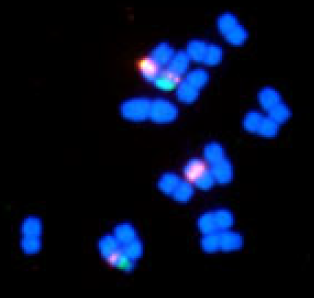 Original Contrasting patterns of the 5S and 45S rDNA evolutions in the Byblis liniflora complex (Byblidaceae)Kenji Fukushima, Kaori Imamura, Katsuya Nagano, and Yoshikazu Hoshi*Journal of Plant Research 124: 231–244. Mar 2011
Original Contrasting patterns of the 5S and 45S rDNA evolutions in the Byblis liniflora complex (Byblidaceae)Kenji Fukushima, Kaori Imamura, Katsuya Nagano, and Yoshikazu Hoshi*Journal of Plant Research 124: 231–244. Mar 2011o clarify the evolutionary dynamics of ribosomal RNA genes (rDNAs) in the Byblis liniflora complex (Byblidaceae), we investigated the 5S and 45S rDNA genes through (1) chromosomal physical mapping by fluorescence in situ hybridization (FISH) and (2) phylogenetic analyses using the nontranscribed spacer of 5S rDNA (5S-NTS) and the internal transcribed spacer of 45S rDNA (ITS). In addition, we performed phylogenetic analyses based on rbcL and trnK intron. The complex was divided into 2 clades: B. aquatica-B. filifolia and B. guehoi-B. liniflora-B. rorida. Although members of the complex had conservative symmetric karyotypes, they were clearly differentiated on chromosomal rDNA distribution patterns. The sequence data indicated that ITS was almost homogeneous in all taxa in which two or four 45S rDNA arrays were frequently found at distal regions of chromosomes in the somatic karyotype. ITS homogenization could have been prompted by relatively distal 45S rDNA positions. In contrast, 2-12 5S rDNA arrays were mapped onto proximal/interstitial regions of chromosomes, and some paralogous 5S-NTS were found in the genomes harboring 4 or more arrays. 5S-NTS sequence type-specific FISH analysis showed sequence heterogeneity within and between some 5S rDNA arrays. Interlocus homogenization may have been hampered by their proximal location on chromosomes. Chromosomal location may have affected the contrasting evolutionary dynamics of rDNAs in the B. liniflora complex.
2009
-
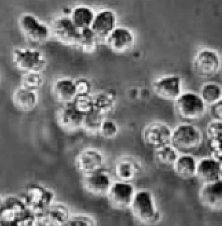 Original Drosera rotundifolia and Drosera tokaiensis suppress the activation of HMC-1 human mast cellsKenji Fukushima, Kanji Nagai, Yoshikazu Hoshi, Saeko Masumoto, Ichiho Mikami, Yumiko Takahashi, Hideaki Oike, and Masuko Kobori*Journal of Ethnopharmacology 125: 90–96. Aug 2009
Original Drosera rotundifolia and Drosera tokaiensis suppress the activation of HMC-1 human mast cellsKenji Fukushima, Kanji Nagai, Yoshikazu Hoshi, Saeko Masumoto, Ichiho Mikami, Yumiko Takahashi, Hideaki Oike, and Masuko Kobori*Journal of Ethnopharmacology 125: 90–96. Aug 2009ETHNOPHARMACOLOGICAL RELEVANCE Several Northern Hemisphere Drosera species have been used in the therapy of respiratory tract infections as the traditional medicine Droserae Herba. AIM OF THE STUDY To determine the anti-inflammatory effects of Drosera species and to investigate a substitute material for Droserae Herba, we examined the effect of extracts of Drosera rotundifolia, Drosera tokaiensis and Drosera spatulata on activated T cell membrane (aTc-m)-induced inflammatory gene expression in HMC-1 human mast cells. MATERIALS AND METHODS Drosera rotundifolia, Drosera spatulata and Drosera tokaiensis were collected in Japan. Herbs were extracted with 80% EtOH, and subsequently applied to OASIS HLB column. HMC-1 cells were treated with each Drosera column-adsorbed fraction for 15min, and subsequently added to aTc-m and incubated for 16h. Inflammatory gene and protein expressions were determined by DNA microarray, RT-PCR and Western blotting. RESULTS Drosera rotundifolia and Drosera tokaiensis fractions, but not the Drosera spatulata fraction, suppressed inflammatory gene expression induced by aTc-m in HMC-1 cells. CONCLUSIONS Drosera rotundifolia and Drosera tokaiensis suppressed activation of HMC-1 cells induced by aTc-m. Since the Drosera tokaiensis fraction was more effective than the traditionally used Drosera rotundifolia, Drosera tokaiensis is a likely substitute as a source of Droserae Herba.
2008
-
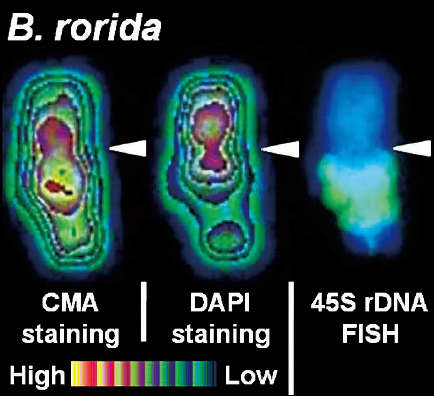 Original Somatic chromosome differentiation in three species of the Byblis liniflora complex (Byblidaceae)Kenji Fukushima, Katsuya Nagano, and Yoshikazu Hoshi*Chromosome Botany 3: 95–99. Dec 2008
Original Somatic chromosome differentiation in three species of the Byblis liniflora complex (Byblidaceae)Kenji Fukushima, Katsuya Nagano, and Yoshikazu Hoshi*Chromosome Botany 3: 95–99. Dec 2008We conducted chromosomal characterizations of three species in the Byblis liniflora complex using sequential fluorescent staining with chromomycin A3 (CMA) and 4’,6-diamidino-2-phenylindole (DAPI), and fluorescence in situ hybridization method. Byblis filifolia and B. rorida had the diploidal chromosome number of 2n=16, while B. liniflora had the tetraploidal chromosome number of 2n=32. All chromosomes of three species were median-centromeric. The primary constrictions, which contain centromeric regions, showed slightly CMA-positive stainability. Two CMA-positive DAPI-negative segments were observed on two chromosomes of the diploids B. rorida and B. filifolia, and the tetraploid B. liniflora. The 45S rDNA signals were detected on two chromosomes of the diploid and the tetraploid species, respectively. The positions of the 45S rDNA were corresponded to CMA-positive DAPI-negative segments.
-
 Original Tandem repeat rDNA sequences derived from parents were stably maintained in hexaploids of Drosera spathulata complex (Droseraceae)Yoshikazu Hoshi*, Junichi Shirakawa, Mitsuyasu Hasebe, Kenji Fukushima, and Katsuhiko KondoCytologia 73: 313–325. Sep 2008
Original Tandem repeat rDNA sequences derived from parents were stably maintained in hexaploids of Drosera spathulata complex (Droseraceae)Yoshikazu Hoshi*, Junichi Shirakawa, Mitsuyasu Hasebe, Kenji Fukushima, and Katsuhiko KondoCytologia 73: 313–325. Sep 2008Drosera spathulata complex, which consists of diploid, tetraploid and hexaploid populations, is widely but disjunctively distributed from eastern part of Australia throughout the South East Asian countries, to Japan. Among these populations, high morphological changing has been found in this species. To investigate intraspecific DNA polymorphism, and to infer the polyploid origin, some populations and cultivars of the Drosera spathulata complex and close related species were investigated using molecular cluster analysis with nucleotide sequences of the large subunit of ribulose-1,5-bisphosphate carboxylase (rbcL), and the internal transcribed spacer (ITS) of 18S-26S nuclear rDNA sequences (ITS). The rbcL analysis to estimate the species as maternal inheritance revealed that the highest similarity to the hexaploid sequence was found in that of the tetraploid. In contrast, the nuclear rDNA analysis clarified that the hexaploid had two types of ITS sequences: One type of the sequence showed the highest sequence similarity to ITS in D. rotundifolia L. genome, while another type of sequence showed the highest sequence similarity to ITS in the tetraploid D. spathulata Labill. genome. These results suggested that the hexaploid genome could be derived from amphiploidizaion between ancestor species of D. rotundifolia as paternal genome, and the tetraploid D. spathulata as maternal genome.
-
 Original Bitter gourd suppresses lipopolysaccharide-induced inflammatory responsesMasuko Kobori*, Hirosuke Nakayama, Kenji Fukushima, Mayumi Ohnishi-Kameyama, Hiroshi Ono, Tatsunobu Fukushima, Yukari Akimoto, Saeko Masumoto, Chizuko Yukizaki, Yoshikazu Hoshi, Tomoaki Deguchi, and Mitsuru YoshidaJournal of Agricultural and Food Chemistry 56: 4004–4011. Jun 2008
Original Bitter gourd suppresses lipopolysaccharide-induced inflammatory responsesMasuko Kobori*, Hirosuke Nakayama, Kenji Fukushima, Mayumi Ohnishi-Kameyama, Hiroshi Ono, Tatsunobu Fukushima, Yukari Akimoto, Saeko Masumoto, Chizuko Yukizaki, Yoshikazu Hoshi, Tomoaki Deguchi, and Mitsuru YoshidaJournal of Agricultural and Food Chemistry 56: 4004–4011. Jun 2008Bitter gourd (Momordica charantia L.) is a popular tropical vegetable in Asian countries. Previously it was shown that bitter gourd placenta extract suppressed lipopolysaccharide (LPS)-induced TNFα production in RAW 264.7 macrophage-like cells. Here it is shown that the butanol-soluble fraction of bitter gourd placenta extract strongly suppresses LPS-induced TNFα production in RAW 264.7 cells. Gene expression analysis using a fibrous DNA microarray showed that the bitter gourd butanol fraction suppressed expression of various LPS-induced inflammatory genes, such as those for TNF, IL1α, IL1β, G1p2, and Ccl5. The butanol fraction significantly suppressed NFκB DNA binding activity and phosphorylation of p38, JNK, and ERK MAPKs. Components in the active fraction from bitter gourd were identified as 1-α-linolenoyl-lysophosphatidylcholine (LPC), 2-α-linolenoyl-LPC, 1-lynoleoyl-LPC, and 2-linoleoyl-LPC. Purified 1-α-linolenoyl-LPC and 1-linoleoyl-LPC suppressed the LPS-induced TNFα production of RAW 264.7 cells ...
2007
-
 Original A comparative study of karyotypes in two species of Byblis (Byblidaceae)Yoshikazu Hoshi*, Kenji Fukushima, and Katsuya NaganoChromosome Botany 2: 39–43. Jun 2007
Original A comparative study of karyotypes in two species of Byblis (Byblidaceae)Yoshikazu Hoshi*, Kenji Fukushima, and Katsuya NaganoChromosome Botany 2: 39–43. Jun 2007Byblis filifolia and B. liniflora had the diploidal and the tetraploidal chromosome numbers of 2n=16 and 32, respectively. In condensation behavior from prophase to metaphase, most chromosomes of both species had early condensing segments at the proximal regions. At prometaphase and early-metaphase, all chromosomes except for some small sized chromosomes had decondense segments at the distal regions in both arms. At mid-metaphase, well-spread chromosomes were quite rare to obtain, because all chromosomes at mid-metaphase stage were quite sticky nature, but not earlier stages of metaphase and prophase. The metaphase chromosomes in both species showed a gradual decrease in size from the largest to the smallest. In B. filifolia, total chromosome length at early-metaphase was 40.5 μm, while total chromosome length at mid-metaphase was 23.3 μm. In contrast, B. liniflora showed total chromosome length of 106.1 μm at early-metaphase, and 54.0 μm at mid-metaphase. To compare to the same stage of metaphase, the total length in B. liniflora was nearly twice as long as that of B. filifolia. Two sat-chromosomes were observed in both species.